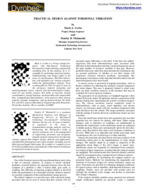Papers
“Practical Design Against Torsional Vibration,” |
Abstract
One of the foremost concerns facing turbomachinery users today is that of torsional vibration. In contrast to lateral vibration problems. torsional failures are especially heinous since the first symptom of a problem is often a broken shaft, gear tooth, or coupling. The difficulty of detecting incipient failures in the field makes the performance of a thorough torsional vibration analysis an essential component of the turbomachinery design process.
The authors’ purpose is to provide users with a practical design procedure that can be used to ensure that their systems will not
encounter major difficulties in the field. It has been the authors’
experience that most turbomachinery users encounter little difficulty in determining their machine’s natural frequencies due to the large number of resources available in that area. However, problems often arise when they must translate this information into an accurate prediction of whether or not their design will experience torsional vibration problems. Accordingly, this presentation concentrates on the steps that should be taken once the natural frequencies have been found.
A cursory review is presented of popular procedures, such as Holzer’s method, for obtaining the machine’s natural frequencies and mode shapes. This area is purposely limited in detail since there are many excellent resources in the literature that may be consulted for a more rigorous treatment.
The generation of an interference or Campbell diagram is then treated in far more detail. Of particular interest is generation of the upward sloping lines representing the system’s excitation frequencies. The various excitation sources commonly found in turbomachinery, such as gears, vaned impellers, and electric motors, are discussed along with the excitation frequencies that each introduces into the system. The unique problems associated with the startup of systems driven by synchronous motors are also described.
Once the interference points have been generated, the user then generally has two choices for dealing with them. Either design changes, such as alteration of couplings, are implemented to eliminate the interferences or the interference points are subjected to further analysis. Many users automatically opt for the first alternative, since they believe they must avoid resonance conditions at all costs. While this is an admirable and worthy goal under ideal circumstances, the cost of achieving it is often unwieldy.
Instead, the procedure provided herein advocates analysis of all interference points prior to the implementation of costly design changes. The analysis might be as simple as inspection of the appropriate mode shape or the unit’s torque vs speed curve. Interference points can frequently be eliminated from consideration based on these inspections revealing that the induced torques are negligible. The resonant points that cannot be thereby removed should be investigated using a damped forced vibration analysis.
Detailed guidelines for performing the damped analysis are presented herein. Methods for determining the magnitudes and locations of excitation torques for various machinery classes are given. Procedures are provided for obtaining damping coefficients for typical sources such as impellers, shaft material hysteresis, and couplings. Finally, users are provided with ground rules for utilizing the calculated cyclic torques and stresses to determine their design’s adequacy.
If the analysis identifies problem areas, practical and relatively simple rectification methods are provided. Lastly, a complete step-by-step analysis procedure is given that summarizes the entire preceding discussion. This methodology can be utilized in the design of virtually any turbomachinery system the user may encounter.

